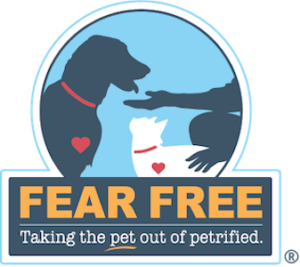By Liz Bales, VMD, Guest to Fear Free
I graduated from veterinary school in 2000. I am sure that when you started practice, you were confident and brave in all of your diagnosis and treatment choices. Me, not so much. I worried every day about getting everything right and doing the very best that I could for my patients and clients. I am not sure when the day came that I stopped the constant worry and began to feel comfortable in my veterinary skin, but it did come. After a few years, I found a way of doing things that worked best for me: my “go to” antibiotics, pain meds, blood work panels, and even the communication styles that were most effective with my clients.
Now, make no mistake, I was attending my continuing education and staying current with the latest medical information. It was very important to me to do the best that I could for my patients, but I was in a rhythm, and that rhythm was working very well for me.
I had my way of doing things, and I couldn’t imagine how I could change it.
Then, in 2014, everything changed for me. I was at a typical continuing-ed conference in feline internal medicine and behavior. The topics ranged from obesity to urinary disease, from house soiling to upper respiratory infections. And one after another, each of these topics had an environmental component. For the first time, I heard the term feline environmental enrichment (EE). In closing, the lecturer covered the AAFP position statement:
“As part of the wellness exam, it is the responsibility of the veterinarian to discuss the current state of the environment and to provide resources for EE to indoor-cat owners. It is well known that if an appropriate environment is not provided for indoor cats, they are at greater risk of stress- induced illnesses and conditions such as:
- Feline lower urinary tract disease
- Obesity
- Different forms of aggression
- Overgrooming and other compulsive disorders
- Upper respiratory infection
In an attempt to prevent the above conditions, it should become routine for the veterinary team to inform owners of the importance of EE and to provide resources to owners. It is also important to consider EE in shelter cats for the same reasons.”
Wait. What? Until now, I was treating these conditions with antibiotics, special diets, anti-anxiety medications, L-lysine, etc., and I was leaving the root cause ignored. I had no idea that for a cat, a human home is just a giant cage, and without providing that cage with the resources that cats need to feel safe and secure we are actually causing these problems.
I knew I had to do better for my patients. I had to change my practice to include environmental enrichment education for my clients. The cats deserve it. And if not their veterinarian, then who?
But how was I going to fit all of this information into my already jammed office visits? That’s a lot of client education! And even if I did, most of the solutions to these problems required arts and crafts projects. There were almost no commercially available solutions to solve these environmental enrichment dilemmas.
And that’s when my 1970s TV watching came back to inspire me. Yep. Popeye.
At the end of the day, I am what I am–but that’s not all that I am. I have figured out a way to bring feline environmental enrichment and the tools to implement it into my practice, and I am still improving. I am now a Catvocate–an advocate for raising the standard of care for cats. It has been a self-help journey toward improvement.
I am looking forward to sharing this journey with you over the coming months. I kinda feel like it’s been a 12-step program of sorts. It certainly has changed my outlook on how I care for cats and improved their outcomes. Of that I have no doubt.
Next month: Step One – Admit There Is A Problem




